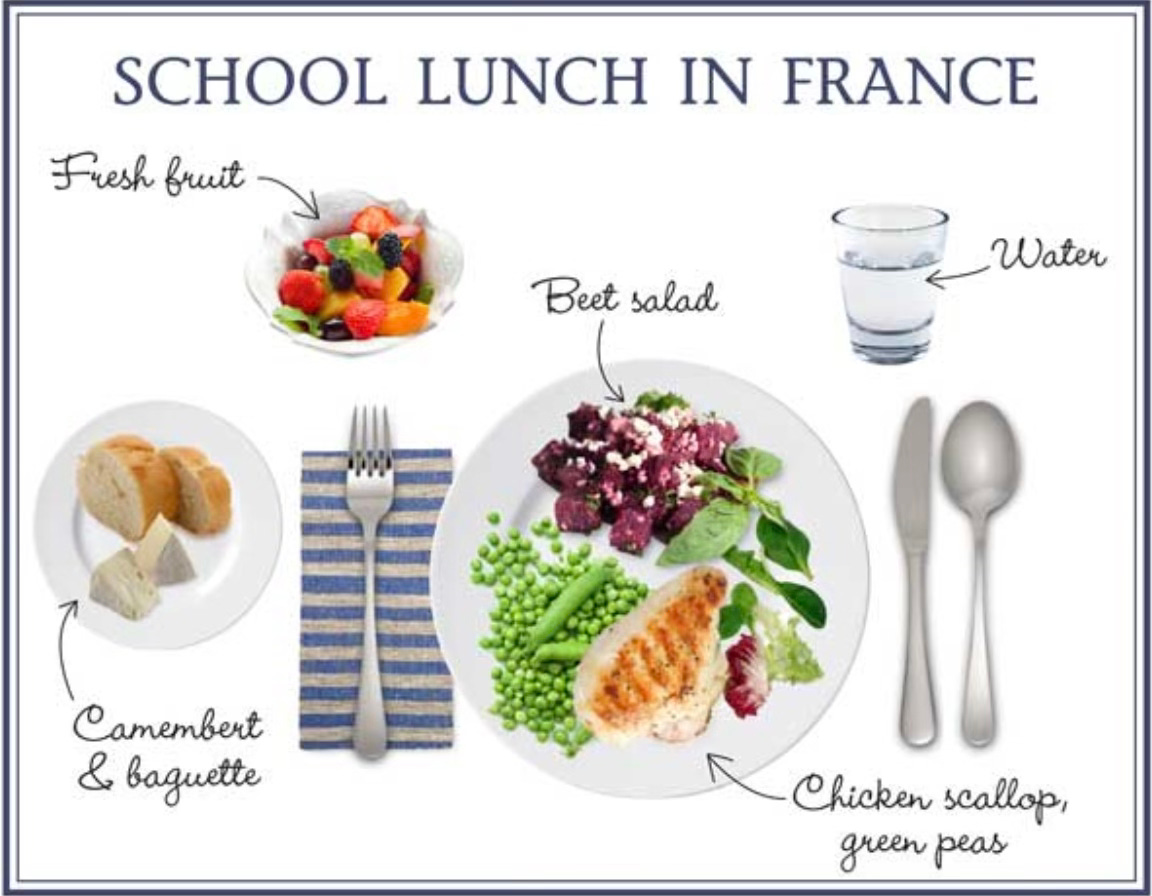Since moving to France in April of 2023 (following the death of my husband of 50 years), one of my greatest pleasures has been rushing to pick up my two grandchildren at the one-room schoolhouse in the tiny village of Monthelie.
I couldn't wait to hear what they had for le déjeuner!
I already knew that they loved school and didn't mind the dreaded weekly dictée. After keeping French pure (the 40 Immortals in L'Académie Française do that), Le Déjeuner Scolaire, the “3- to 4-course hot, main lunch, subsidized by the government, is sacrosanct. French even has a word for socializing and eating together – la commensalité – signifying what Americans once believed: that a family that eats together stays together.
Rarely do you see the French eating lunch or dinner alone in one of France's 10,000 restaurants, bistros, and cafés. The exception is for la pause café or morning coffee, where the French prefer to be alone with a croissant, daily newspaper and quite possibly a cigarette.
French Habits are Changing… for the Better
The recent insistence on bio and organic food, locally grown and free from pesticides, has become essential to le Déjeuner Scolaire. There are even specific cooking schools to teach future chefs what and how to cook for French cantines scolaires (cafeterias) and cantoneurs or cantineuses to oversee the lunch hour and even, for the youngest, to cut up their Cordon Bleu.
Here in La Côte d'Or, where le terroir (that mystical French combination of nature at its best when soil, humidity, and sun make good-to-great Burgundian wines so precious) also extends to fruit, vegetables, and rich grass that nourish the famous white Charolais beef, along with an infinite variety of chèvre (goat cheese). Other areas of France that don't have such an embarrassment of natural riches, offer their students less choice and quality than La Côte D'Or.
On Sundays, all over France, le déjeuner is de rigeur and en famille and lasts the afternoon, in many cases. But It's up to the French state to make sure six million French children are well educated, well fed, and learned in gastronomy.
Starting in primary school and continuing through high school (when children take the very demanding Bac, French school children are given a starter, main dish, vegetables, fruit, bread, cheese, water, and a dessert. The menus are posted on-line, usually a week or two ahead with suggestions for the light le souper (evening meal) to complete the nutrition balance the state deems essential for growing and educating children.
One wonders if the reason French children seem smarter and more cultured than many other European children is due to the obligatory déjeuner and the rich patrimony to which they are exposed from early childhood. Making foodies in the cantine is as important as teaching the difference between a simple verb and one in the past tense. Plus, thanks to Napoleon Bonaparte, the French love Camembert.
The History of Camembert (the Short Version)
Legend has it that in 1791, during The French Revolution, a farmer named Marie Hamel took in a priest to hide him from an angry crowd who wanted to guillotine him. The priest was from the town of Brie where he had learned cheese making. In return for hiding him, he taught her how to make a fine Brie. In the process, something went awry, and they made Camembert instead. When Napoleon tasted the cheese, he named Marie Hamel's town Camembert. It took another hundred years for Camembert to bust out of its hometown and another thirty to really become a part of the French diet. During world War l, French soldiers from the north brought the cheese with them to battlefields and on leave home to all parts of Le Hexigone.
One Australian, blogging mother, Karen Billon, who writes about kids' school lunches, lived in Versailles, and says she was surprised to see roasted guinea fowl on the menu for her primary school child's lunch. She quotes from another website in an answer to why the French put so much energy into healthy lunches: “Mealtime is a particularly important part in a child's day. Our responsibility is to provide children with healthy, balanced meals; to develop their sense of taste; to help children, complementing what they learn at home, to make good food choices without being influenced by trends, media, and marketing; and to teach them the relationship between eating habits and health. But above all else, we aim to enable children to spend joyful, convivial moments together to learn ‘Savoir-Vivre.’
Most Children Have a Favorite (French) Cheese
Another blogger points out that most French children aren't obese, as many American and U.K. children –who snack on calorie-laden drinks and sugar-filled treats – are. French children think a hunk of cheese or salami sticks are treats. If you ask a French child to name his favorite cheese, he will rattle off at least six and will then have to stop and think which is his favorite. Ninety-nine percent of French eat cheese daily. The taste for French cheese starts the moment a toddler is hungry for something that adults eat.
Recently, I took a poll of my five grandchildren, who all praised their French school lunches (although three now live in Australia, where their mother must make lunch again). Camembert, Brie, Comté and Raclette (probably because their mothers grew up in Switzerland and during cold, winter nights we often had melted raclette poured over boiled potatoes and gherkins) were all named. One of the thirteen-year-old twins in Australia said that Lou Perac was his favorite.
Of my two grandchildren living in France, my eight-year-old granddaughter also mentioned Camembert (there are now more than 100 types of the ubiquitous, soft, white cheese made all over France (and even in Japan) instead of traditional Normandy). It is the second choice of the French after yellow, hard with small holes Emmental, one of France's least expensive cheeses. My granddaughter’s 11-year-old brother said Raclette was his favorite, and then Gouda, which he recently had as an entrée (Cordon Bleu dipped twice in egg and breadcrumbs and then deep fried). He waxed poetically about how the creamy cheese and ham interior complemented the yummy double crust. The Gouda choice stunned me as: a) Gouda is Dutch and b) with over 1,000 French cheeses and the French being the largest European cheese exporter, why would the French choose a foreign fromage? Price probably. Nationwide, school lunches cost 3.5 euros and families pay according to their salaries.
Perhaps we must thank Édouard Manet and his Déjeuner Sur l'Herbe for his infamous impression of a French picnic-lunch that includes baguettes, cheese, wine, and buxom babes for educating French children how to savor their déjeuner.
The French school lunch has only existed since the end of World War II, during which many French starved. Along with a well-balanced lunch, the Fifth Republic deemed that schoolchildren should also be given at least 30 minutes to eat their meal as ingesting and socializing take time and must be followed by at least an hour of play before returning to the classroom.
•••
Perhaps the new U.S. Secretary of Health and Human Services (HHS) Robert F. Kennedy, Jr. is taking notes!
*****
Please help spread the word about the value and readability of SBCurrent.com by sharing this article with friends and neighbors. Use the button below or copy the URL to share, ensuring they too stay well-informed. Thank you.
*****
Take a look at COLAB’s latest video, “The Great Fee Heist”







Calla, my mother's family is French Canadian and I attended a French Canadian Catholic school in the 4th grade. We had to bring our own lunch (6-oz bottle of whole milk, peanut butter & jelly sandwich on white bread), an apple and a cookie), but most important to me was the afternoon gouter (4 pm-ish), which for us was a slice of hard white bread spread with dark, delicious, molasses!
Food is indeed medicine. When will Americans decide to choose wisely what we consume? I resent being taxed to pay for obesity and the self imposed costly medical problems of others refusing to accept personal responsibility for their own health and well-being. It’s possible to avoid processed foods and liquids including fruit juices containing multiple additives. Locally, a banana, an apple or carrot and celery sticks with string cheese and nuts are easy and preferred to any school cafeteria lunch. It’s easier and cheap to squeeze a lemon or lime into a glass or water or tea. Let’s face it: we’re addicted to the flavors of processed foods and drinks, to eating out. MAHA has increased our awareness: it’s up to us! Now for the hard part: Can we modify our behavior? Practice impulse control? As pointed out by the Author, eating is learned behavior and must be taught.